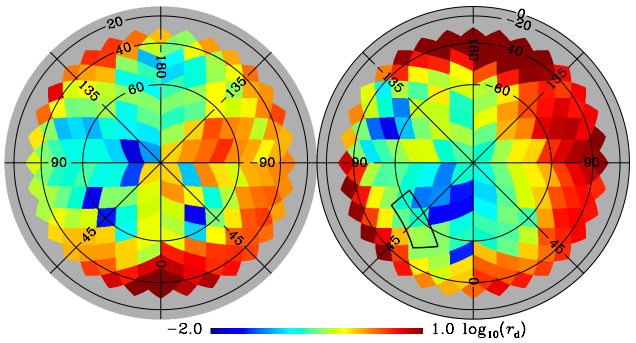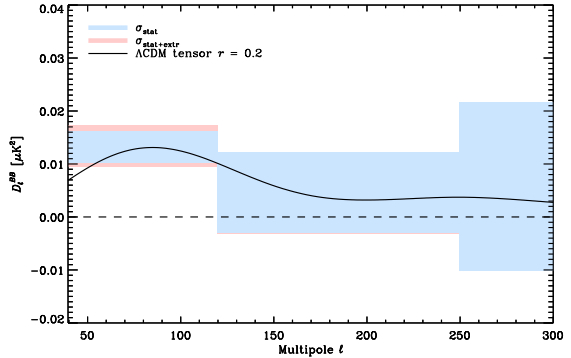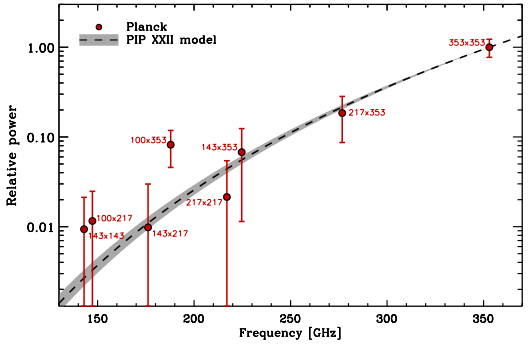Ever since we all heard the exciting news that the BICEP2 experiment had detected “B-mode” polarization in the cosmic microwave background — just the kind we would expect to be produced by cosmic inflation at a high energy scale — the scientific community has been waiting on pins and needles for some kind of independent confirmation, so that we could stop adding “if it holds up” every time we waxed enthusiastic about the result. And we all knew that there was just such an independent check looming, from the Planck satellite. The need for some kind of check became especially pressing when some cosmologists made a good case that the BICEP2 signal may very well have been dust in our galaxy, rather than gravitational waves from inflation (Mortonson and Seljak; Flauger, Hill, and Spergel).
Now some initial results from Planck are in … and it doesn’t look good for gravitational waves. (Warning: I am not a CMB experimentalist or data analyst, so take the below with a grain of salt, though I tried to stick close to the paper itself.)
Planck intermediate results. XXX. The angular power spectrum of polarized dust emission at intermediate and high Galactic latitudes
Planck Collaboration: R. Adam, et al.The polarized thermal emission from Galactic dust is the main foreground present in measurements of the polarization of the cosmic microwave background (CMB) at frequencies above 100GHz. We exploit the Planck HFI polarization data from 100 to 353GHz to measure the dust angular power spectra CEE,BBℓ over the range 40<ℓ<600. These will bring new insights into interstellar dust physics and a precise determination of the level of contamination for CMB polarization experiments. We show that statistical properties of the emission can be characterized over large fractions of the sky using Cℓ. For the dust, they are well described by power laws in ℓ with exponents αEE,BB=−2.42±0.02. The amplitudes of the polarization Cℓ vary with the average brightness in a way similar to the intensity ones. The dust polarization frequency dependence is consistent with modified blackbody emission with βd=1.59 and Td=19.6K. We find a systematic ratio between the amplitudes of the Galactic B- and E-modes of 0.5. We show that even in the faintest dust-emitting regions there are no "clean" windows where primordial CMB B-mode polarization could be measured without subtraction of dust emission. Finally, we investigate the level of dust polarization in the BICEP2 experiment field. Extrapolation of the Planck 353GHz data to 150GHz gives a dust power ℓ(ℓ+1)CBBℓ/(2π) of 1.32×10−2μK2CMB over the 40<ℓ<120 range; the statistical uncertainty is ±0.29 and there is an additional uncertainty (+0.28,-0.24) from the extrapolation, both in the same units. This is the same magnitude as reported by BICEP2 over this ℓ range, which highlights the need for assessment of the polarized dust signal. The present uncertainties will be reduced through an ongoing, joint analysis of the Planck and BICEP2 data sets.
We can unpack that a bit, but the upshot is pretty simple: Planck has observed the whole sky, including the BICEP2 region, although not in precisely the same wavelengths. With a bit of extrapolation, however, they can use their data to estimate how big a signal should be generated by dust in our galaxy. The result fits very well with what BICEP2 actually measured. It’s not completely definitive — the Planck paper stresses over and over the need to do more analysis, especially in collaboration with the BICEP2 team — but the simplest interpretation is that BICEP2’s B-modes were caused by local contamination, not by early-universe inflation.
Here’s the Planck sky, color-coded by amount of B-mode polarization generated by dust, with the BICEP2 field indicated at bottom left of the right-hand circle:
Every experiment is different, so the Planck team had to do some work to take their measurements and turn them into a prediction for what BICEP2 should have seen. Here is the sobering result, expressed (roughtly) as the expected amount of B-mode polarization as a function of angular size, with large angles on the left. (Really, the BB correlation function as a function of multipole moment.)
The light-blue rectangles are what Planck actually sees and attributes to dust. The black line is the theoretical prediction for what you would see from gravitational waves with the amplitude claimed by BICEP2. As you see, they match very well. That is: the BICEP2 signal is apparently well-explained by dust.
Of course, just because it could be dust doesn’t mean that it is. As one last check, the Planck team looked at how the amount of signal they saw varied as a function of the frequency of the microwaves they were observing. (BICEP2 was only able to observe at one frequency, 150 GHz.) Here’s the result, compared to a theoretical prediction for what dust should look like:
Again, the data seem to be lining right up with what you would expect from dust.
It’s not completely definitive — but it’s pretty powerful. BICEP2 did indeed observe the signal that they said they observed; but the smart money right now is betting that the signal didn’t come from the early universe. There’s still work to be done, and the universe has plenty of capacity for surprising us, but for the moment we can’t claim to have gathered information from quite as early in the history of the universe as we had hoped.



though quite disappointing, the results can show what is NOT GW remnants, and therefore, will help in future experiments determining what may be. remember WD40 (Water Dispersant formula # 40) is number 40 because they messed it up 39 times before. we can learn more sometimes by what a thing is not
Pingback: Planck, BICEP2, dust, and science news - foreXiv
Healthy skepticism is as commendable with regard to sensational science news as it is with regard to any news for which “Too good not to be true” applies. Those who didn’t share the elation then are free from the disappointment now. The good news is that the extraordinary claim of inflation still needs extraordinary evidence to look forward to.
Pingback: Gravitational Wave Discovery Looks Doubtful in New Analysis – Scientific American | Everyday News Update
I’m watching all of the interviews on YouTube from back in March of scientists so excited, saying that proof has been found of the Big Bang lol
In all seriousness, this is why you follow the data and not your ideology. It seems that a lot of scientists were allowing their belief in a conclusion (Big Bang) to lead them to evidence to support that conclusion rather than following the evidence to the conclusion itself…where ever it leads them.
@stephen agnew, the question is not whether the big bang occurred; there is solid evidence for that. the question is whether there were primordial gravitational waves generated, and that is questionable (most likely they were produced only with small amplitude, and not seen by BICEP).
Pingback: GRAV WAVE DRAMA: ‘Big Bang echo’ may have been dust on the ‘scope – boffins | News Stories Today
In all the plots shown here, none mentions goodness of fit. Hmmm don’t we care about statistical analysis before making a statement anymore? Thats a good way we make conclusions about our results right? Just asking :3
“We show that even in the faintest dust-emitting regions there are no “clean” windows where primordial CMB B-mode polarization could be measured without subtraction of dust emission.”
That’s too bad.
Is there another propagation mode that would enhance discrimination between dust and gravity waves?
Pingback: Planck CMB Polarization and BICEP2 | WIMPs and Neutrinos
Pingback: Gravitational Wave Discovery Looks Doubtful in New Analysis | The Today Online
If the dust signature is random and the gravitational wave signature has structure, shouldn’t we be able to process the received B-mode signal? Correlating the received signal to the expected gravitational wave signature over a long time would average out the dust if it is zero mean and uncorrelated to the gravitational signature.
First reaction from the Bicep2 team
Backup url if the direct link didn’t work.
Disappointing, but maybe there can be some progress in the detection of gravitational waves if LISA ever gets off the ground. Sad that NASA cut funding, but the ESA seems determined to pursue it.
Have we a new unit of measure?
The following was taken from:
http://www.deccanchronicle.com/131202/news-current-affairs/article/mars-orbiter-moves-out-earth%E2%80%99s-reaches
02Dec2013
“The spacecraft is behaving well after one of the most crucial operations after it was launched by the PSLV on November 5th. Tomorrow, it will cross the lunar distance (distance to the Moon) of 3,84, 490 km. Early on Wednesday (December 4), it will move out of the Earth’s sphere of influence at 9.5 lakh KM. We will carry out corrections in orbit on December 11, in April, August and the early half of September 2014 before the spacecraft reaches the precise orbit around Mars on September 24,” Dr. K. Radhakrishnan, Chairman, ISRO, told Deccan Chronicle.
Hah! I knew it. You can’t have gravitational waves that alter the speed of light due to a theory that doesn’t allow the speed of light to change! It is really no wonder why there is only indirect evidence for gravitational waves.
Monday I was shocked to learn that the trick is due to a publication bias and now we are seeing strong evidence for the proteus phenomenon . I would like to congratulate the BICEP2 and Planck teams for the serendipitous discovery of baryonic dark matter. Does anyone else expect life to evolve and spread through panspermia in older galaxies instead of younger galaxies with radiation producing quasars? Is that like the anthropic principle?
While on the topic, are gravitational waves necessitated by inflationary theory, or can we have a reasonable flavor that avoids them?
Hey, don’t worry about things not working out. Man if you get it right the first time in Science/Physics then your are extremely lucky. It is through experimentation and changing of variables that you may find discoveries. Some of my discoveries that I have made are from pure accidental discoveries- like- hey this shouldn’t of happened or what the heck-what happened.
@Michael O’Brien: Sorry, Indians have not invented a new unit! Lakh is an old unit in India meaning 100,000. In spite of this ancient unit, the spacecraft made it to an orbit around Mars at the first attempt and on a shoestring budget. It is a historic achievement and deserves congrats.
@John Barrett re “You can’t have gravitational waves that alter the speed of light due to a theory that doesn’t allow the speed of light to change!” Check out Baez. The speed of light varies in the room you’re in:
“Einstein talked about the speed of light changing in his new theory. In his 1920 book “Relativity: the special and general theory” he wrote: “… according to the general theory of relativity, the law of the constancy of the velocity of light in vacuo, which constitutes one of the two fundamental assumptions in the special theory of relativity […] cannot claim any unlimited validity. A curvature of rays of light can only take place when the velocity [Einstein means speed here] of propagation of light varies with position.” This difference in speeds is precisely that referred to above by ceiling and floor observers.”
People call this the coordinate speed of light, and confuse it with the locally-measured speed of light, which is constant because we define our second and our metre using the local speed of light, then use them… to measure the local speed of light. It’s a tautology, see http://arxiv.org/abs/0705.4507
Pingback: Scientists got it wrong on gravitational waves. So what? | AllDigitalNews.com
Let’s hope SPIDER gets aloft in December and is successfully retrieved. There may be some answers come next spring.
Pingback: Science by Press Release: Overhyped “gravity waves” were just dust | The k2p blog
Pingback: Morsels For The Mind – 26/09/2014 › Six Incredible Things Before Breakfast